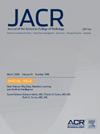Impact of the COVID-19 Pandemic on Breast Biopsy Delays: Factors Contributing to Disparities Across Prepandemic, Shutdown, and Postshutdown Periods
IF 5.1
3区 医学
Q1 RADIOLOGY, NUCLEAR MEDICINE & MEDICAL IMAGING
引用次数: 0
Abstract
Background
The coronavirus disease of 2019 pandemic significantly disrupted health care delivery, leading to delays in diagnostic procedures.
Objective
This study aimed to examine the factors associated with delays in time from diagnostic examination to image-guided breast biopsies during the prepandemic, shutdown, and postshutdown periods.
Methods
This retrospective cohort study included 4,415 examinations with a BI-RADS 4 or 5 assessment recommending image-guided biopsy for 4,197 patients at a multisite academic institution from January 1, 2019, to December 31, 2021. Delays in biopsy were assessed across three periods: prepandemic (January 1, 2019, to February 29, 2020, n = 1,551), shutdown (March 1, 2020, to May 31, 2020, n = 170), and postshutdown (June 1, 2020, to December 31, 2021, n = 2,694). Patient factors included age, race, ethnicity, personal or family history of breast cancer, area deprivation index, employment, insurance, and marital status. Clinical factors included BI-RADS assessment and biopsy modality. t Tests, Wilcoxon’s rank-sum tests, and univariate and multivariate logistic regression analyses were performed to quantify and identify factors associated with biopsy delay.
Results
The median time to biopsy from diagnostic examination significantly increased between the prepandemic (11 days) and postshutdown (16 days) periods (P < .001). Significant biopsy delays, defined as ≥30 days to biopsy, increased between the prepandemic (9%) and postshutdown (12%) periods (P = .001). Compared with the prepandemic period, same-day biopsies increased in the shutdown period (from 8% to 24%, P < .001) due to institutional implementation of same-day procedures during the shutdown, then sharply declined in the postshutdown period (2%, P < .001). Biopsies were independently more likely to be delayed in the postshutdown period compared with the prepandemic period on multivariate analysis (odds ratio [OR] 1.4, P = .004). In addition to time period, patient factors including age between 60 and 70 years (OR 1.5, P = .020) or ≥70 years (OR 1.9, P = .002), Black (OR 1.6, P < .001) or Asian (OR 1.9, P = .003) race, not having a personal history of breast cancer (OR 1.4, P = .018), being unemployed (OR 1.5, P = .005) or uninsured (OR 2.7, P = .001), being unmarried (OR 1.4, P = .004), and undergoing stereotactic (OR 1.3, P = .013) or MRI (OR 4.7, P < .001) biopsies were significant predictors of delay in the prepandemic and postshutdown periods on multivariate analysis.
Conclusions
Delays in breast biopsies increased between the prepandemic and postshutdown periods. Significant delays were more prevalent among older, racial minority, unemployed, uninsured, and unmarried patients during the study period, with the postshutdown period independently predicting significant delays.
Clinical impact
These findings highlight the need for continued interventions to mitigate the effects of health care disruptions, particularly for vulnerable populations, to ensure timely breast cancer diagnoses during and in the recovery period following future health care crises.
COVID-19大流行对乳腺活检延迟的影响:导致大流行前、停工和停工后差异的因素。
背景:2019冠状病毒病大流行严重扰乱了医疗服务,导致诊断程序延迟。目的:本研究旨在探讨在大流行前、停药期和停药后,从诊断检查到影像引导乳腺活检的时间延迟的相关因素。方法:本回顾性队列研究包括4415项检查,BI-RADS 4或5评估,推荐图像引导活检4197例患者,于2019年1月1日至2021年12月31日在一个多地点学术机构进行。在三个时期评估活检延迟:大流行前(2019年1月1日- 2020年2月29日,n=1551)、停工(2020年3月1日- 2020年5月31日,n=170)和停工后(2020年6月1日- 2021年12月31日,n=2694)。患者因素包括年龄、种族、民族、乳腺癌个人/家族史、地区剥夺指数、就业、保险和婚姻状况。临床因素包括BI-RADS评估和活检方式。采用t检验、Wilcoxon秩和检验以及单因素和多因素logistic回归分析来量化和确定与活检延迟相关的因素。结果:从诊断检查到活检的中位时间在大流行前(11天)和停工后(16天)期间(p=30天)显著增加,在大流行前(9%)和停工后(12%)期间增加(p=0.001)。与大流行前相比,关闭期间当天活检增加(从8%增加到24%,p=70年(OR 1.9, p=0.002), Black (OR 1.6)。结论:大流行前和关闭后期间乳房活检延迟增加。在研究期间,显著延迟在老年、少数种族、失业、无保险和未婚患者中更为普遍,关闭后的时间独立预测显著延迟。临床影响:这些发现强调需要继续采取干预措施,以减轻医疗保健中断的影响,特别是对弱势群体的影响,以确保在未来医疗保健危机期间和恢复期间及时诊断乳腺癌。
本文章由计算机程序翻译,如有差异,请以英文原文为准。
求助全文
约1分钟内获得全文
求助全文
来源期刊

Journal of the American College of Radiology
RADIOLOGY, NUCLEAR MEDICINE & MEDICAL IMAGING-
CiteScore
6.30
自引率
8.90%
发文量
312
审稿时长
34 days
期刊介绍:
The official journal of the American College of Radiology, JACR informs its readers of timely, pertinent, and important topics affecting the practice of diagnostic radiologists, interventional radiologists, medical physicists, and radiation oncologists. In so doing, JACR improves their practices and helps optimize their role in the health care system. By providing a forum for informative, well-written articles on health policy, clinical practice, practice management, data science, and education, JACR engages readers in a dialogue that ultimately benefits patient care.
 求助内容:
求助内容: 应助结果提醒方式:
应助结果提醒方式:


